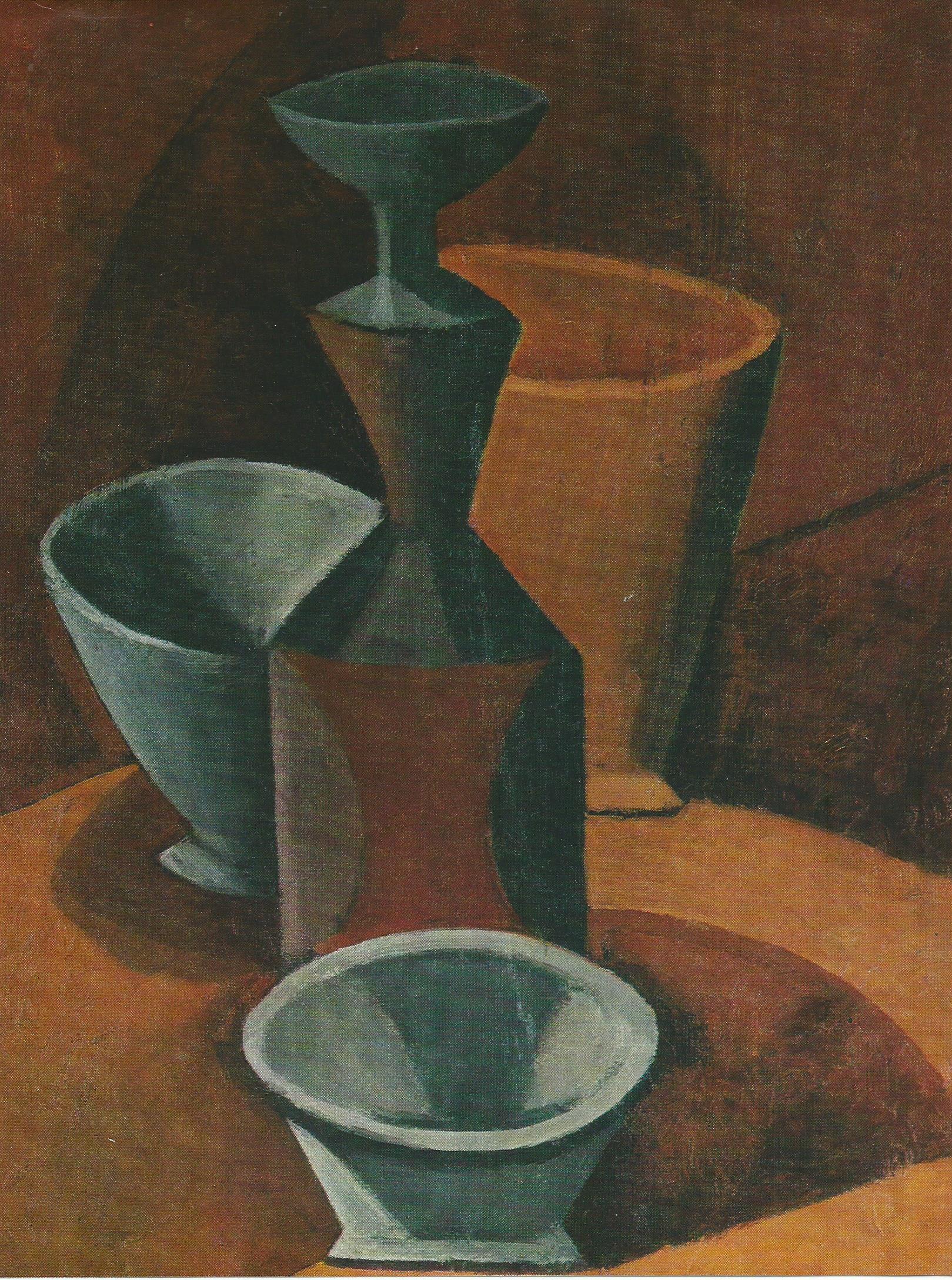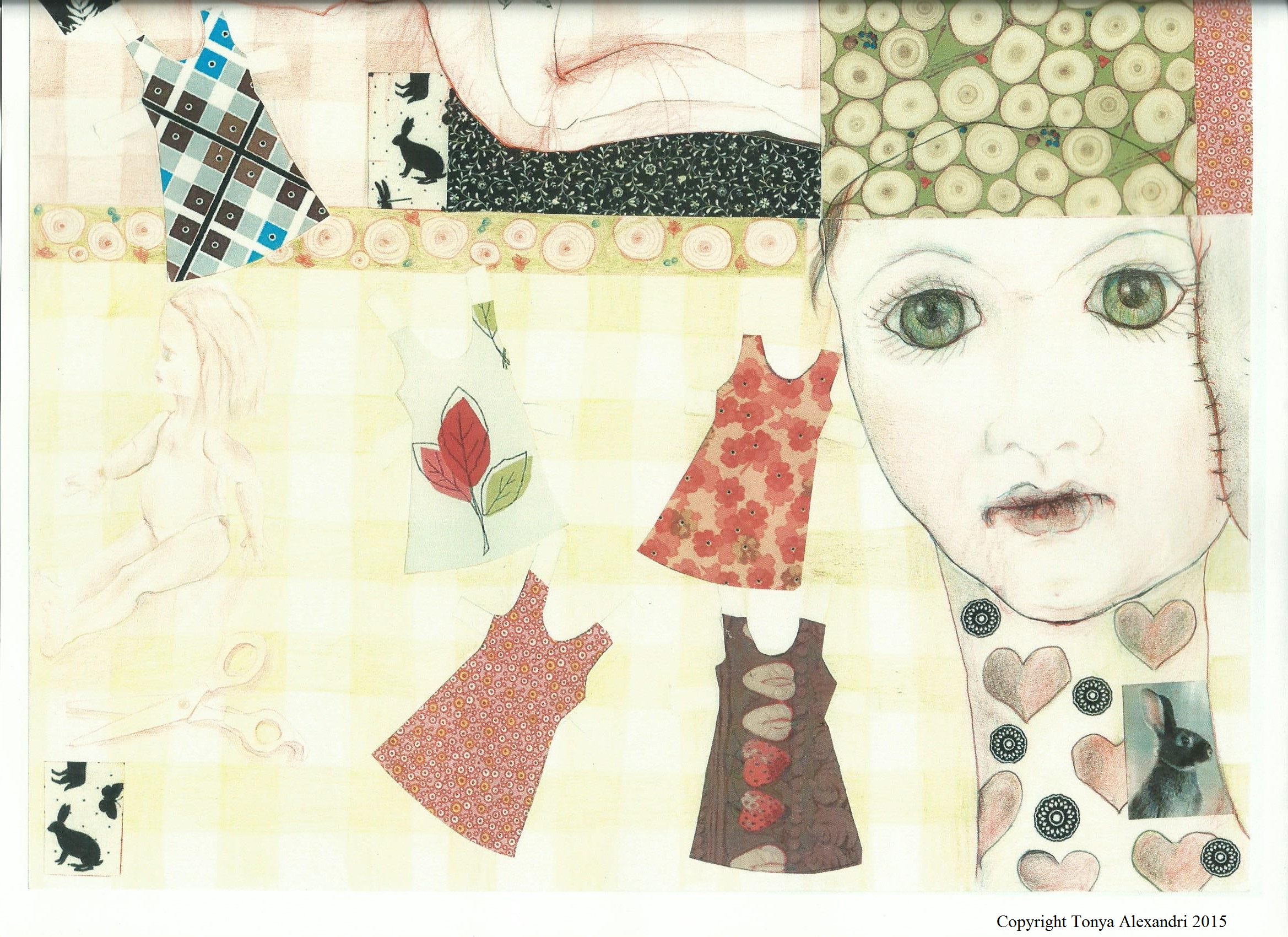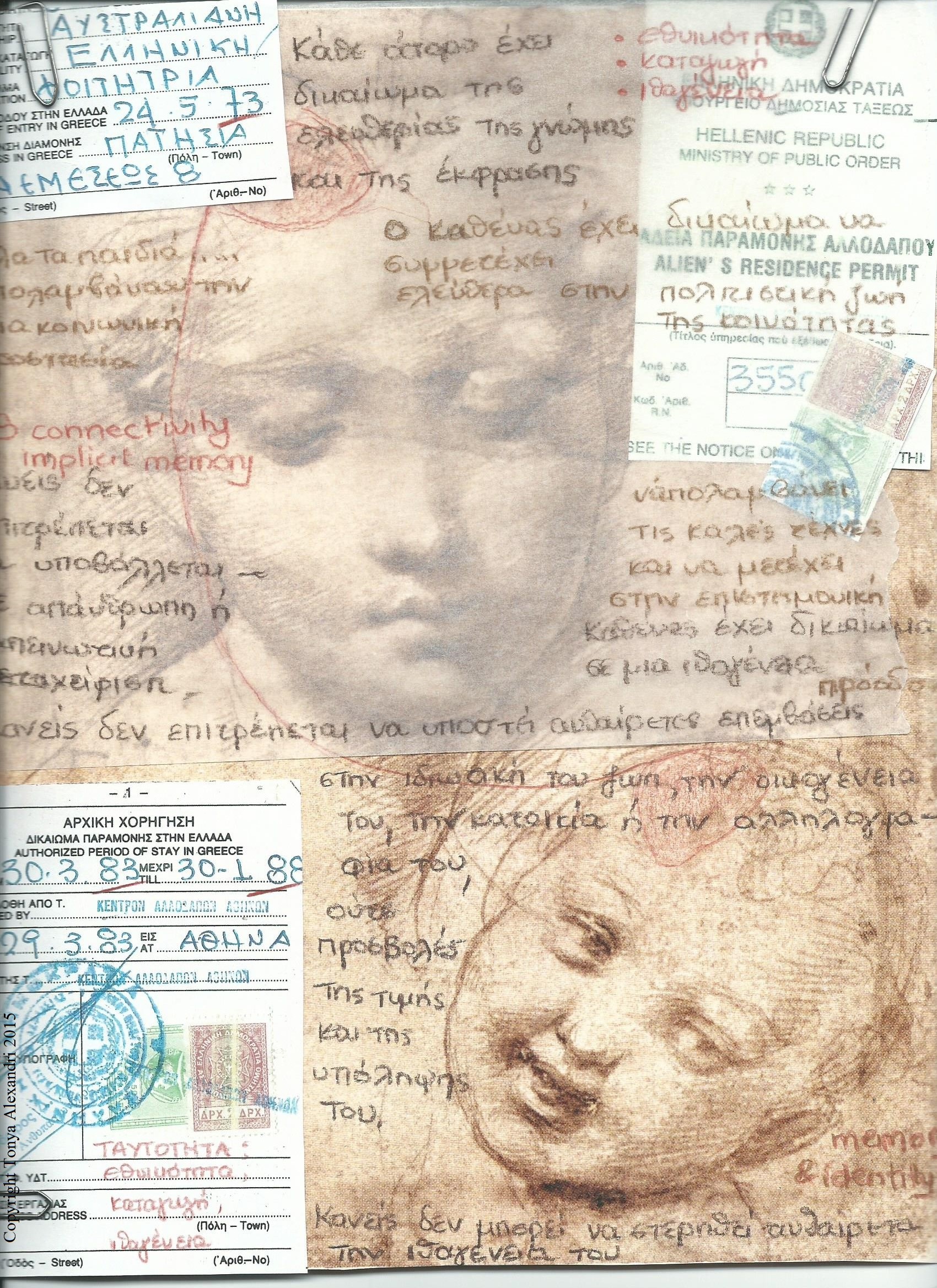Bowls, metaphors, triggers and past learning, the mind and integration Pitcher and bowls, oil on cardboard, 1908, by Pablo Picasso
Pitcher and bowls, oil on cardboard, 1908, by Pablo Picasso
Ι recently re-watched The Road Home by Zhang Yimou a Chinese film about the love and long courtship between a village girl and a young school teacher that arrives from the big city. There was an interesting scene in this film where the people in the village had their cracked china bowls restored by a travelling craftsman for they could not afford to replace them. Some years ago an old friend, Sophie, who was living in Japan, sent me an origami kit and a book on restoration of broken pottery. In Japan they have a special word for restoring broken bowls and cups – kintsugi. Broken china and pottery is repaired with gold or silver; therefore, in some sense the mended container becomes more valuable and interesting than the original one. This is not simply repairing and recycling for practical reasons and the philosophy behind this is that breakage and repair is treated as part of the history of the object.
Anyway, all the above experiences reminded me of the metaphor of the shattered vase or bowl, which is often used by trauma survivors or/ and therapists. Actually, a while ago I too may have used this metaphor to describe the experience of trauma and the attempts to restore and heal. However, the acquisition of experience and more knowledge concerning the mind, integration and neuroplasticity has made me realise, now, that this metaphor may not be that helpful in the end. In any case, it now seems (to me) inadequate because I think that imagining or perceiving the mind or the self as a container of any sort is somehow rather limiting. It conjures up an image of the self or the mind as rather solid, static, finite and fixed, quantifiable and measurable, instead of something open to change, in a state of constant flow and in constant interaction with one’s environment. Our mind is a function of our embodied and relational brain, which as research has shown has the potential to change throughout our lifespan, for better or for worse, because the brain has the capacity to change its structure in response to all our experience, through the activation of our neurons. Dan Siegel writes that ‘even the focus of attention is a form of experience that activates neurons, turns on genes, and makes structural changes to the connections among neurons. In this way, the mental process of focusing attention can change the physical structure of the brain’. He writes ‘We are our attention. The more intense and perhaps specific our neural firing (which we create with the focus of our attention), the more long-lasting synaptic changes we will likely initiate in our brain’. Also, our mind does not only relate to our inner subjective experience, but also exists in the space between us and others. It is relational and it has a regulatory aspect, which has to do with our health and well being. Dan Siegel writes that the mind can be defined as ‘a process that regulates the flow of energy and information within our bodies and within our relationships’. More specifically, he proposes that the mind is ‘an emergent, self-organizing process that gives rise to our mental activities such as emotion, thinking, and memory’. He writes that ‘this aspect of mind is a natural, emerging, and self-organizing dynamic process that arises as a fundamental property of the system of energy and information flow that is created in both the body and in interactions with others and our environment. This emergent process arises from energy and information flow and then also shapes energy and information flow across time’.
Additionally, the metaphor of the shattered vase or bowl does not seem to capture the processes of recovery, healing and movement through life as well as Dan Siegel’s metaphor of the river of integration, for instance. I think that recovery, healing and empowerment require working towards integration at all levels of one’s life, which seems to be something deeper and more demanding and complex than simple mending and this is what the first metaphor perhaps suggests (to me at least). One could generally define integration as the interaction and communication of differentiated parts of any system. Concerning our brain it means that the different regions and parts of regions are in constant interaction with each another. Dan Siegel suggests that ‘linkage means that subsets interact with one another….. . For a mind, this means that various mental activities, such as, thinking or feeling or remembering, the various aspects of a state of mind, have an impact on other activities or states and can interact and collaborate with one another. In the brain, energy and information flowing from one region has access to and influences the other areas of the brain in a reciprocally impactful way’. Dan Siegel writes on integration ‘the central flow of the river is in the movement of harmony and the banks of the river represent the states of chaos and rigidity, when we are not in an integrated flow’. Trauma, torture, abuse, neglect, surgery, serious accidents, natural disasters, abandonment or loss of parents at an early age, combat, extreme poverty and displacement, violent assaults and other difficult experiences can impair the integrative fibers of the brain. Impaired integration results in chaos and/ or rigidity, which cause less than optimal function and allows past experience and learning to dominate the present, often with devastating effects. Working towards integration enables the coordination and harmony of mind and body, which in turn can have a positive impact on one’s relationships and life circumstances. Working towards higher levels of integration seems synonymous to well-being and personal strength. Furthermore it is an ongoing – constant process that requires deep changes to take place in our brain and our environment, which inevitably interact and impact each other. We often forget that external experience determines the structure of our brains and our mental activities and functioning. Even dealing with severe trauma in a safe, supportive and harassment free environment is not the same as coping with post traumatic effects while being homeless, living in extreme poverty or in an abusive or hostile environment. In any case, integration is not something to be achieved and done with or a final product, but a lifelong process for everyone, especially survivors. Siegel views ‘integration as a verb, not a noun, we can continually move toward an integrative flow. As a river continuously flows, our life unfolds in the direction of continual emergence. Integration is the intention and the direction of life, not a final product or fixed endpoint of a journey. Integration truly is the journey, not the destination’.
Mindfulness is one way we can increase self-awareness and knowing and achieve greater integration. Mindfulness involves training our mind to monitor and change and it helps us attune both to ourselves and to others. Practising mindfulness or focusing our attention inwards can allow us to bring our cortex on line to soothe our aroused and hyper-functioning limbic system in order to deal with our current experience more appropriately. In the case of survivors, especially those of prolonged trauma, being mindfully aware of present experience along with gradual and wise exposure to triggering stimuli in the environment can contribute to increased functioning and desensitization to triggers. Dan Siegel writes that ‘freeing ourselves from the potential tyranny of top-down domination (such as the sometimes continual chatter of our narrative self) that obliterates, or at least obscures, the freshness of bottom-up (as in our experiencing self) may be a lifelong challenge for many human beings. Living creatively, allowing new, spontaneous combinations of experiences to emerge as we live our lives, may be all about freeing our bottom-up processes and allowing their emergence to blossom’. Being mindfully aware of present experience prevents our future and past oriented top-down processes to dominate and influence our new bottom up processes. So for instance, in the case of a bowl, we may see a bowl of fruit or cream or cereal and while our bottom-up experience senses it as if it were the first time, top-down processing already knows what it is and what’s more it interferes by generating summaries of all prior experiences and ‘encounters’ with a bowl. It automatically floods us with all kinds of prior knowledge and expectations, accumulated across the years. Unfortunately, in the case of trauma survivors, there are bound to be plenty of negative and self-defeating experiences and narratives, which may prompt behaviours that are totally inappropriate and self-sabotaging in the current context. So past experience, learning and schemata can interfere with fresh new experience and can cause us to behave in an exaggerated manner as in hyper-arousal or it can lead to avoidance, denial and dissociation. Innocent or neutral stimuli and incoming information can trigger trauma survivors, and thus, produce symptoms and undesirable responses – all based on past learning and experience.
Therefore, stimuli that other people may take for granted can cause significant distress to survivors and can lead to self-defeating decisions, out of context emotions and attitudes. There are quite a few references on triggers elsewhere on this site, but I feel the need to very briefly make some reference here again because I strongly believe that ‘diffusing’ triggers is an absolutely essential step to liberating the self from past negative learning and to increasing safety and healing. It also prevents survivors from re-victimization or repeating old ineffective behaviours in new contexts, thus preventing new losses. Actually, I now believe that recognising triggers and working towards integration are the two most important aspects of restoration and recovery from trauma. Triggers can prompt traumatic responses, symptoms and emotions because they cue the brain to gather and send particular memories. All this takes place under conscious awareness, which leaves survivors vulnerable to new manipulation or suffering. Triggers can set off flashbacks and fragments of memories, which may take one back to the original traumatic event or even worse, generate responses that are inappropriate in the current context. It is also important to know that triggers are activated through our five senses: sound, sight, smell, taste and touch. For example, as far as sound is concerned, anything that resembles anger like loud voices, shouting or swearing or sounds that may resemble pain like crying or screaming may all potentially trigger behaviours and emotions like fear, anxiety, helplessness, avoidance, etc. Also, sounds that may have been present in the place where the abuse or traumatic experience took place like music, drills, car horns or alarms, sirens, doors banging, glass breaking, a phone or a bell ringing, even the chirping of birds, can all potentially interfere with current behaviours and processing. Similarly, words, verbal comments and triggering stories, films or news can all produce similar fearful reactions and symptoms. For instance if a particular TV programme was on then this background information can potentially cause future distress and can also surface as part of a traumatic memory or a flashback. Concerning sight, people resembling abusers, even similar clothes and mannerisms, common or widely used gestures, colours and objects that may have been present in the environment where the traumatic experience took place or observed by the survivor prior or immediately after the experience. For example, if someone was hurt in a place with a bike leaning against the wall or if the first thing one saw after the trauma was someone cycling or a bike, then cycling or/ and bikes will potentially trigger fear or memories in many harmless future contexts. Furthermore, watching a film with an accident involving a bike could further reinforce the fear or even embellish and increase it and so on. One can imagine, for instance, how many things could trigger someone if they were hurt near a table or a room full of objects. Because all this takes place under our conscious awareness and because we do not acknowledge a bike, a gesture, etc, as triggering stimuli we cannot bring our cortex to step in, process our response and soothe our overwhelmed limbic system. Any smell that resembles the smell of the abuser or the context, like smoke or alcohol, bad odor, perfume, after shave, food being cooked in the room, etc, can also trigger memories or responses. Similarly, any kind of taste related to the actual event or prior and after the event can potentially produce unwanted reactions, suffering and even health deterioration. If a child, for instance, is punished severely and then is soothed by being offered a bar of chocolate or an ice-cream, later on the child or adult will repeatedly be triggered because they either do not remember the pairing (violence, pain, terror, helplessness, chocolate or ice cream) or/and are not able (for several reasons) to make the link between the negative experience and the innocent stimuli. As a result, a simple bar of chocolate or an innocent cone of ice cream will potentially trigger memories and set off unhelpful responses until processed and dealt with. Additionally, because our brain tends to make generalizations all kinds of chocolate sweets or ice cream flavors may trigger unwanted emotions and behaviours. It is easy to understand that for survivors of prolonged trauma triggers can severely impact their functioning and decision making. Finally, any type of touch or sensation that may resemble traumatic context or even proximity of someone who resembles the situation can produce similar post traumatic responses. In the end, if one thinks about it, trauma and victimization is a learning process, which involves bad, scary, self-defeating and often inhumane lessons. Acquiring knowledge about triggers and behaviourism, as a learning theory, can prove an additional invaluable tool, if one is to recover from painful past lessons. The understanding of the impact of triggers and how they were created, as well as, gradual exposure are an essential part of the journey.
Tonya Alexandri, September 19th, 2015
References
Masters of World Painting: Pablo Picasso, 1979, Harry N. Abrams, INC, Publishers New York & Aurora Art Publishers, Leningrad
Daniel J. Siegel, 2012, Pocket Guide to Interpersonal Neurobiology: An Integrative Handbook of the Mind (Norton Series on Interpersonal Neurobiology), W. W. Norton & Company
 Paper cutting and origins (part of drawing 2007-2008) – Dedicated to an old student, Anna
Paper cutting and origins (part of drawing 2007-2008) – Dedicated to an old student, Anna

